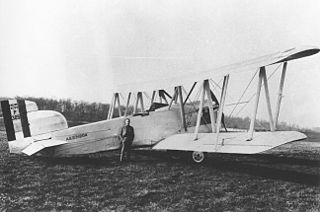Related Research Articles

Nieuport, later Nieuport-Delage, was a French aeroplane company that primarily built racing aircraft before World War I and fighter aircraft during World War I and between the wars.

The Tupolev I-4 was a Soviet sesquiplane single-seat fighter. It was conceived in 1927 by Pavel Sukhoi as his first aircraft design for the Tupolev design bureau, and was the first Soviet all-metal fighter.

The Short Springbok was a two-seat, all-metal reconnaissance biplane produced for the British Air Ministry in the 1920s. All together six aircraft of the Springbok design were built but none entered service with the armed forces.

The Armstrong Whitworth A.W.14 Starling was a British single-engine biplane fighter developed for the Royal Air Force in the 1920s. The plane was an unsuccessful model, with the Bristol Bulldog being selected instead.

The Kawasaki KDA-5 was a Japanese single-seat biplane fighter designed by the German Dr. Richard Vogt for the Imperial Japanese Army.
The Martin KF-1 was an American biplane fighter aircraft designed and built by Captain James V. Martin.

Polikarpov DI-1, also known as 2I-N1, Russian: Поликарпов ДИ-1 (2И-Н1), was a prototype Soviet two-seat fighter designed during the 1920s. The sole prototype built crashed on its ninth flight, due to manufacturing defects, and the program was cancelled.

The Nieuport-Delage NiD 42 was a fighter aircraft built in France in the early 1920s, the first in a family of designs that would form the backbone of the French fighter force over the next decade.
The Port Victoria P.V.2 was a British prototype floatplane fighter of the First World War, designed and built at the Royal Naval Air Service's Port Victoria Marine Experimental Aircraft Depot on the Isle of Grain. Only a single aircraft was built, with the type not being chosen for production.

The Port Victoria P.V.8 Eastchurch Kitten was a prototype British fighter aircraft of the First World War designed and built by the Port Victoria Marine Experimental Aircraft Depot on the Isle of Grain. It was a small and light biplane with a conventional wheeled undercarriage intended to operate from platforms on small ships, but while it had good handling, an unreliable and underpowered engine meant that the aircraft did not enter production, with only one prototype being completed. In 2014, a replica Kitten – originally started in the 1980s – was completed by enthusiasts at the Yorkshire Air Museum.
The Port Victoria P.V.1 was a British prototype floatplane fighter of the First World War, built at the Royal Naval Air Service's Port Victoria Marine Experimental Aircraft Depot on the Isle of Grain by fitting a Sopwith Baby with high-lift wings. Only a single aircraft was built, with the type not being chosen for production.
The Sopwith B.1 was an experimental British bomber aircraft of the First World War. A single-seat, single-engined biplane, the B.1 was built by the Sopwith Aviation Company for the Royal Navy. Although only two were built, one was used for bombing raids over France.
The Grain Griffin was a British carrier-based reconnaissance aircraft developed and built by the RNAS Marine Experimental Depot, Port Victoria, during the First World War. A development of the unsuccessful Sopwith B.1 bomber, the Grain Griffin was a two-seat single-engined biplane that was built in small numbers for Britain's Royal Naval Air Service, being used operationally during the British intervention in the Russian Civil War.

The Tebaldi-Zari was an Italian fighter prototype of 1919. The Breda company later acquired the rights to it.

The Engineering Division TP-1 was a two-seat biplane fighter designed by Alfred V. Verville and Virginius E. Clark at the United States Army Air Corps Engineering Division. A second aircraft was completed as an observation biplane and designated the Engineering Division XCO-5.
The Port Victoria P.V.9 was a British single-seat biplane floatplane fighter of the First World War. Although claimed to be the best aircraft of its type yet to be tested, only a single prototype was built.
The Port Victoria P.V.4 was a prototype two-seat reconnaissance floatplane of the First World War. The P.V.4 was a small single engined pusher biplane. It was unsuccessful as the engine it was designed around was a failure and alternatives were unsuitable, only one aircraft being built.
The Vickers E.F.B.1 'Destroyer' was an early British military aircraft prototype. Although not itself a success, the design was considered worth developing, and a series of similar aircraft were produced in prototype form, eventually leading to the Vickers F.B.5 "Gunbus", which saw widespread service during World War I.
The Port Victoria P.V.5 was a British single-engined floatplane fighter aircraft of the First World War. A single example was built and flown at the Royal Naval Air Service's Port Victoria Marine Experimental Aircraft Depot on the Isle of Grain in 1917. Despite demonstrating good manoeuvrability and handling, no production followed, with the Royal Naval Air Service instead using landplanes for the fighter role.

The Levy Biche LB.2 was a single seat French sesquiplane fighter aircraft designed to be used from aircraft carriers. With a watertight fuselage, jettisonable wheeled undercarriage and small under-wing floats, it could survive emergency sea touchdowns; it could also be fitted with seaplane type floats.
References
- Bruce, J.M. War Planes of the First World War: Volume One Fighters. London:Macdonald, 1965.
- Collyer, David. "Babies Kittens and Griffons". Air Enthusiast , Number 43, 1991. Stamford, UK:Key Publishing. ISSN 0143-5450. pp. 50–55.
- Mason, Francis K. The British Fighter since 1912. Annapolis, Maryland:Naval Institute Press, 1992. ISBN 1-55750-082-7.